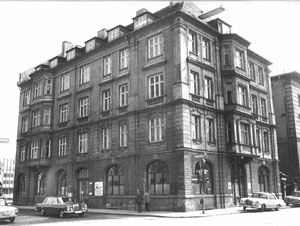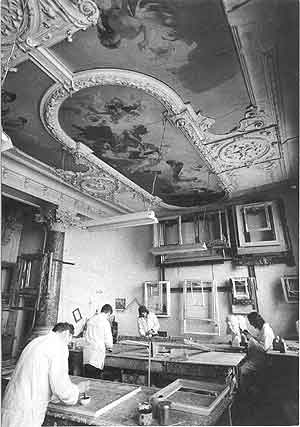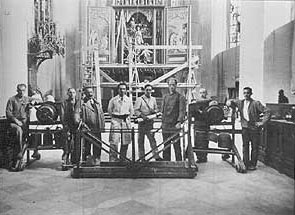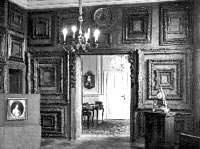|
History of the Pfefferle Arts and Crafts Workshop
The history of the company mirrors a chapter in the history of Bavarian arts and crafts, and also the preservation of monuments and historical buildings, within the last 130 years and up to now has encompassed five generations.
It all began with the boom in arts and crafts in Bavaria during the last years of the reign of King Max II and which enticed the qualified artisan and “Fassmaler” (painter and gilder of sculptures and other such artworks) Joseph Pfefferle, the great-grandfather of the present-day company proprietor and bearer of the name, to come to Munich from Tyrol. In 1859 he founded the Pfefferle Framing and Gilding Workshop at number 30 Brienner Street, the oldest specialized business in Munich. He worked closely with distinguished artists such as Defregger and Gabriel von Seidl. In 1872 Joseph Pfefferle was awarded citizenship and from then on he was referred to as a painter and gilder, later on as “Fassmaler”, in the directory of Munich residents. His grave is to be found amongst those of scholars and artists in the culturally and historically interesting Old North Cemetery in Munich.
His son Karl Pfefferle (2nd generation) relocated the workshop to its own quarters at number 6 Türken Street, and started setting up the collection of frames that formed the foundation of the present wide variety of individual, handcrafted, and customized frames. During this time extensive reframing of pictures for the Old and New Pinakothek ensued. The workshops expanded to cover restoration contracts from churches at home and abroad. In 1939 the House of Pfefferle received the contract to restore both the interior and the fixtures and fittings of the Franciscan Church in Salzburg. The focus was on the restoration of the High Altar by Johan Fischer von Erlach from 1709/10.
Under the administration of his son Karl Pfefferle (3rd generation), after the 2nd World War the following significant projects were carried out: the complete supervision of the restoration of the interior fitments in the Cuvillieés Theatre in Munich; the reconstruction of the frame for the “Schaffner Altar” in the Old Pinakothek; new frames for the Lenbachhaus museum in Munich (A. Macke, A. Jawlensky, F. Marc, L. Corinth et al.); as well as the restoration of the Gothic, carved timber ceiling in the High Castle of Füssen, and the reconstruction of the Renaissance organ cabinet for the Church of St. Anna in Augsburg. Furthermore, the firm took over the total supervision of the fitments during the restoration of the Frauenkirche (Church of Our Lady).
The present-day proprietor is his son Karl Pfefferle (4th generation) who, after the tragic death of his father during the completion of the work at the Cuvilliéves Theatre in 1967, took over the running of the company. The headquarters of the parent company in Munich’s museum district had to make room for the construction of the Old City ring road. The company then moved to the Lehel area of Munich, not far from the House of Art (Number 5 Gewürzmühl Street). Extensive projects pertain to supplying new frames for the Nußbaum collection in the Felix Nußbaum museum, designed by Daniel Libeskind, in Osnabrück, and the reconstruction of the frames for the historical paintings in the Augsburg town hall.
(See References)
Since 1990 Michael Pfefferle (5th generation) has been active in the company. Recently, the conceptual designs of frames for the Villa Stuck museum in Munich, for a Rembrandt painting in the Prince of Liechtenstein’s collection, and for the Museum at the Ostwall in Dortmund (August Macke) have been implemented. We were also significantly involved in new concepts for the framing of the graphic art collection in the Albertina museum in Vienna. Up till today approximately 70 masterpieces of European art history have been framed in accordance with historical master copies in our establishment, from Dürer, Brueghel, Tintoretto, Rubens through Tiepolo and beyond to Boucher.
(See Collection)
The core business of the company today is the production of individual replicas of historical frames in accordance with master copies from our very own collection. In this field our company enjoys an international reputation.
|
 |




